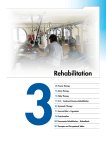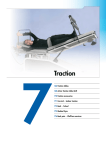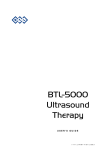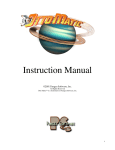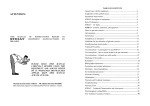Download User Manual - Posture Monitoring Feedback
Transcript
Posture Monitoring Feedback Teorema Project 02036 INCLINOMETER 02038 POSITIONAL FEEDBACK 02037 GONIOMETER This set comprises two positional feedback devices known as an Inclinometer and GONIOMETER. User’s manual EDITION 02.2013 Special contents are combined to this document: Follow us on The positional feedback inclinometer and GONIOMETER dealt with here are part of a larger set of rehabilitation aids named LEONARDO and explained in the Rehabilitation section of Chinesport general catalogue. posture MONITORING Feedback Teorema Project User’s manual CONTENTS 04 Introduction 05 INCLINOMETER 05 Presentation 05 Three types of Feedback 05 Inclinometer Tilting Adjustment 06 Single parts and their application 08 GONIOMETER 08 Presentation 09 Single parts and their application 11 MOTORIAL LEARNING PHASES 11 APPLICATION EXAMPLES 11 Compensation 1 - Elevating the scapula 12 Compensation 2 - Counter sideways inclination of the trunk 12 Compensation 3 - Homolateral inclination of the trunk 13 Compensation 4 - Counter sideways inclination of the trunk 13 Compensation 5 - Extension of the trunk 14 Compensation 6 - Flexion of the trunk 14 Compensation 7 - Flexion of the trunk posture MONITORING Feedback Teorema Project INTRODUCTION By means of this exercise the patient must achieve gradual perfecting of movements, from the complexity required for shoulder, arm, forearm, and elbow movements, to fine movements at the wrist distal, hand and fingers. To make a stable position possible for the arm for which fine use of the hand is activated, proximal control of the trunk is fundamentally important. Attention must not be focussed solely on interaction with the aid, but must also take the way the patient uses the various areas of their body into account. Simple gestures like opening / closing a door or window, and taking a glass of water, if included in therapeutic contexts with position monitoring instruments, are very useful for correct functional relearning. The use of position feedback instruments (inclinometer - goniometer) makes it possible to draw the patient’s attention to the motorial behaviour of areas of their body, of which the patient is not always fully aware, providing information on performance, and focussing attention on important aspects of the gesture. Also adding Feedback has a motivating effect and produces an immediate increase in performance. Page 4 posture MONITORING Feedback Teorema Project INCLINOMETER PRESENTATION The inclinometer is a sensor that closes an electric circuit when movements occur on the frontal - saggital plane, providing position feedback, as it reads absolute movements of the body (trunk movements, in the examples that follow) and provides information on them. THREE TYPES OF FEEDBACK The signalling device can be visual, acoustic or vibratory. Visual feedback (FB) is useful when “setting” the instrument, to determine the angle beyond which the patient will feel the stimulus (sound / vibration). This avoids confusion being created, by providing the patient with a signal only when correctly set. In the most advanced learning stage, self-evaluation exercises are provided for (“summary feedback”) in which the therapist watches the LED and has an objective parameter to compare with the perception expressed by the patient while executing a series of tests. Sound FB is commonly used because it informs the patient timeously and precisely, drawing their attention to the motorial behaviour of the area involved. It is particularly useful for patients that tend to have limited attentive participation in the treatment. Vibrating FB is provided by a “vibrating pad” 2 cm in diameter, which will be positioned near the area of muscle you wish to stimulate / block. This results in the patient reducing the time lapse between information and response, because they do not have to interpret a sound or LED, but receive the information at the point monitored. TYPE OF FEEDBACK ACOUSTIC FEEDBACK VIBRATORY FEEDBACK VISUAL FEEDBACK Visual / acoustic / vibratory FB has a warning and alarm meaning in relation to an incorrect gesture (negative FB) or recognition of correct execution (positive FB). For the same movements, the inclinometer is positioned in opposite directions to implement the two different modes (see the images of flexing the trunk, and Compensation n° 7 below) Inclinometer Tilting Adjustment To set the range beyond which the feedback is activated, simply adjust the antenna, changing the tilt on it. The closer it is to the horizontal position, the more sensitive it will be to movements on that plane. The antenna is screwed to a support that is positioned using a velcro strip on the front or back of the thoracic viewer strap. In the two images above information is provided on movements in the frontal plane (lt-rt inclination). In the images below the reference plane is the saggital (flexing - extending). Page 5 posture MONITORING Feedback Teorema Project Single parts and their application 02036 INCLINOMETER ELEMENTS INCLUDED IN THE KIT A Inclinometer B Electrical connection C Inclinometer support D Strap for thoracic indicator E Thoracic indicator F Additional acoustic signaling device G Vibrating pad 1 2 3 4 A Inclinometer The antenna that houses the inclinometer (3) must be inserted, using the threaded screw (2), into the electrical connection hole (4) and screwed to the timber support (6). The plug (1) must be inserted into the external connections 12 for the additional signaling device F. 2 3 1 B Electrical connection The plug (5) must be inserted into the external con nections 12 for the additional signaling device F. 5 4 C Inclinometer support The Velcro on the side opposite to that of the timber support can be connected to the back of the inclinometer support (10), or to the front of the strap (8). 6 Pagina 6 posture MONITORING Feedback Teorema Project D Strap for thoracic indicator To put on the inclinometer harness, first position the elastic strap at the height of the sternum, with the Velcro fixing (7) behind the trunk. 7 8 E Thoracic indicator 10 9 Rest the Y-shaped inclinometer support on the shoulders. The two longer ends (9) must be connected to the elastic Velcro strap at the front (8), whereas the shorter part (10) is “wedged” in at the back between the male Velcro (pin) (7) and female Velcro (slot) on the elastic strap. 9b F Additional acoustic signaling device 13 12 15 14 The bottom of the box has a female piece of Velcro on it that is used to connect it to the male Velcro (9b) on the inclinometer support. Push the functionality button (11) to check the battery status. Use the external connections (12) to insert the plug for the inclinometer (2) and the plug for the electrical connection (5). Use the buzzer / LED switch (13) to switch from visual mode (LED-14) to Acoustic mode (buzzer). To activate the vibrator FB, insert the plug (17) in hole 15 and position the buzzer / LED switch (13) to LED. When the circuit is closed the vibrating pad and LED are activated simultaneously. 11 G Vibrating pad 16 17 The vibrating pad (16) must be put in contact with the skin, keeping in in place with some tape or by positioning it under the straps. It is adjusted by changing the inclination on the antenna. The antenna must always be rotated to the right, in order to avoid it being loosened by rotating it in the opposite direction. The closer one gets to the horizontal, the more the system becomes sensitive to inclinations of the trunk. If the antenna is positioned at the back (Photo 1), it informs the person of an increase in bending of the trunk; if is it positioned in the front (Photo 2) on the elastic straps, it will indicate when the trunk is extended beyond the range set. If positioned with the pointer to the right (Photo 3), it will pick up inclinations of the trunk to the left, and vice-versa (Photo 4). Page 7 posture MONITORING Feedback Teorema Project GONIOMETER PRESENTATION This is an elastic structure that follows the patient’s movements and informs them when they have reached / passed a predefined joint angle. This aid works on relative angles, also monitoring joints that do not have a stable rotation axis, such as the thoracic scapula because, unlike other joint measuring systems, it is not positioned on the fulcrum, but is moved away in relation to the movement of the joint segments, closing the circuit and activating the sensor. The instrument is put in place using velcro strips or double-sided tape applied to the skin. Adjustment is done by changing the length of a cable laid parallel to the elastic. When doing the exercises if elevation, tipping or rotation of the thoracic scapula is picked up, when it should be stabilised, the feedback is very effective. Also, given the difficulty of correctly perceiving the area, application of the vibrating pad on the muscle group to be activated, facilitates control. NOTE: This aid can also be used for other joints and various “tasks”. TYPE OF FEEDBACK ACOUSTIC FEEDBACK VIBRATORY FEEDBACK VISUAL FEEDBACK When the elastic element is positioned behind the elbow (as in the figure) a range is determined, beyond which the FB is activated. By inverting the position, one can ask for a certain degree of extension to be reached / exceeded (positive FB). For each of the items described on the previous pages the goniometer can be used if you want to draw the patient’s attention to the behaviour of the proximal joints. NOTE: The Inclinometer and the Goniometer can provide a visual, sound, or vibratory signal if incorrect posture occurs when a patient is busy doing some work. The feedback device to be positioned on the patient is chosen to suit the type of compensation to be monitored. See the description of the individual items contained in these pages and the illustration of the compensations below. Page 8 posture MONITORING Feedback Teorema Project Single parts and their application 02037 GONIOMETER ELEMENTS INCLUDED IN THE KIT A Goniometer B Velcro /double-sided tape connectors C Thoracic indicator strap D Extension E Velcro strap for goniometer F Additional acoustic signaling device G Vibrating pads A Goniometer The goniometer circuit is closed and the acoustic/ vibratory signal is activated when the non-stretch wire (3) is tensioned. The movement arc over which the signal is activated, is set by adjusting (4) the length of the wire (3). The FB is switched off by the action of the elastic (5) that retracts the wire, shortening it. The elastic element (6) acts as a clutch, as it allows the subject to go beyond the angle established, without causing the instrument to lock up, resulting in it breaking. The longer the elastic (6) is left the longer the period of time the FB will remain active. Otherwise, if you wish to switch the FB off quickly and are working with a limited articular range, use the adjustment buckle on the elastic (7) to keep the elastic (6) at a lesser length. The external connectors (12) on the additional signaling device are used for connecting up the plugs on the goniometer (2). Push the functionality button (11) to check the battery status. 7 4 The Velcro connectors (1) at the ends of the goniometer can be connected: 3 • To the Velcro / double-sided tape connectors (B) • To the thoracic viewer strap (C) • To the (male) Velcro extension (D) • To the 2 Velcro straps for the goniometer (E) (For elbow exercises). 6 5 1 2 B Velcro /double-sided tape connectors For exercises for the thoracic scapula joint, hook up the ends of the goniometer (1) to the two connectors (B) that have double-sided tape on the opposite side to the Velcro. Remove the protective paper and stick to the skin so that raising, tilting or abduction of the scapula will cause the protector to be tensioned. Page 9 posture MONITORING Feedback Teorema Project C Thoracic indicator strap Alternatively, the elastic strap for the thoracic viewer can be positioned at the top of the hips, attach the extension (9) to the strap (8) and connect it to the Velcro connector on the goniometer (1), fixing the opposite end (1) close by, using the Velcro / double-sided tape connector (B). Replace the doublesided tape for each new application. 8 D Extension 9 E Velcro strap for the goniometer For elbow exercises, position the two Velcro straps (E) one nearby on the arm, just above the bicep venter and the other at a distance on the forearm, so that they cannot slip towards the elbow joint. Position the Velcro connectors (1) on the male Velcro (10) portion of the two straps. 10 F Additional acoustic signaling device 13 12 15 14 Use the buzzer / LED switch (13) to switch from visual mode (LED-14) to Acoustic mode (buzzer). To activate the vibrator FB, insert the plug (17) in hole 15 and turn the buzzer / LED switch (13) to LED. When the circuit is closed the vibrating pad and LED are activated simultaneously. 11 G Vibrating pad 16 17 Page 1010 Pagina The vibrating pad must be put in contact with the skin, keeping it in place using tape or by positioning it under one of the straps. posture MONITORING Feedback Teorema Project MOTORIAL LEARNING PHASES Evaluating the strategy used by the patient in completing the gesture required is of fundamental importance, in order to choose the feedback instruments to be used and where they must be positioned. Often the patient uses compensation strategies to complete the task in the most simple, economic manner. Therefore we want to ensure that, by means of the exercised proposed, the patient gradually perceives and learns the correct motorial behaviour strategy. Motorial learning phases include an initial phase during which feedback is constant and acts on an afferent channel, looking for selective monitoring of the movement and posture. In the second and third phases the information on details of the movement is gradually reduced. Here summary feedback is important for getting to an automatism phase, with open exercises in variable contexts. This is the line taken when seeking to provide the patient with the information required to do a task with the correct Postural alignment, reducing compensation to a minimum. For explanatory purposes, let’s analyse the compensations used by patients more often on various planes and how to position the feedback devices to allow them to perceive their error and complete the functional task in the best possible way. APPLICATION EXAMPLES COMPENSATION 1 ELEVATING THE SCAPULA In this task involving reaching the handle, there is a need to avoid the patient compensating by using the scapula-thoracic joint, to make a movement that must physiologically mainly be carried out by the scapulohumeral joint. The proximal part of the goniometer is positioned using double-sided tape at the scapular spine and the velcro strip is used to connect the lower part to the thoracic strap. By adjusting the wire the range of elevation for the scapula is defined, beyond which the circuit is closed and the FB signal is activated. INCORRECT POSITION CORRECT POSITION Plane Posture Task Compensation Tool Type of FB Frontal Standing Reaching the handle Elevating the scapula Goniometer Negative feedback Page 11 posture MONITORING Feedback Teorema Project COMPENSATION 2 COUNTER SIDEWAYS INCLINATION OF THE TRUNK Another compensation mechanism that a patient can use is to bend the trunk to avoid abducting the arm or flexing the elbow. What is being sought is monitoring of the trunk on the frontal plane while the hand reaches the handle. The inclinometer is positioned on the velcro strip on the thoracic viewer, with the antenna facing in the opposite direction to inclination of the trunk. The system is activated when the antenna goes beyond the horizontal. The more the antenna is pointed downwards, the greater the range left to the patient for using inclination compensation before getting the signal to stop. INCORRECT POSITION CORRECT POSITION Plane Posture Task Compensation Tool Type of FB Frontal Standing Reaching the handle Counter bending of the side of the trunk Inclinometer Negative feedback COMPENSATION 3 HOMOLATERAL INCLINATION OF THE TRUNK When making the gesture of turning the handle, the patient can use the trunk to “reinforce” the movement, which should be done exclusively by the upper limb. Compared to the previous situation the inclination is opposite, that is on the same side as the limb working. The antenna will therefore be aligned in the opposite direction and the patient will receive <0 FB as soon as they move the trunk on the frontal plane. INCORRECT POSITION Page 12 CORRECT POSITION Plane Posture Task Frontal Standing Reaching the handle Compensation Homolateral inclination of the trunk Tool Type of FB Inclinometer Negative feedback posture MONITORING Feedback Teorema Project COMPENSATION 4 COUNTER SIDEWAYS INCLINATION OF THE TRUNK This exercise involves turning the handle anticlockwise. This movement is done mainly due to abduction of the arm. The patient will probably be able to do the task at a certain height, but will have difficulty if the handle is positioned higher up. The inclinometer on the trunk makes it possible to precisely determine the point at which the patient begins to have difficulty and use the trunk to compensate to a possible joint deficit of the shoulder. Being able to monitor the trunk on the frontal plane and to move the handle to a known height makes it possible to highlight a patient’s improvement during a single session or over a number of sessions. INCORRECT POSITION CORRECT POSITION Plane Posture Task Compensation Tool Type of FB Frontal Standing turning the handle anticlockwise Counter inclination sideways of the trunk Inclinometer Negative feedback COMPENSATION 5 EXTENSION OF THE TRUNK For this exercise, the patient’s difficulty may be linked to a flexing deficit for the arm. Applying the inclinometer to the back immediately indicates any compensation by extending the trunk during the task of positioning an item in the support. Below an arm flexion of 120°-150° in fact, the trunk should not be involved. In this case too, as in the previous case, being able to adjust the support to the required height, allows the therapist to work on the specific nature of the functional task. As for all the exercises with FB, the task can be made easier or more difficult by adjusting the inclination of the antenna. Plane Posture Task Compensation Tool Type of FB Sagittal Standing Putting an item on a shelf Extension of the trunk Inclinometer Negative feedback Page 13 posture MONITORING Feedback Teorema Project COMPENSATION 6 FLEXION OF THE TRUNK For patients with a hunchback posture that is difficult to correct, providing positive FB when correct extension of the trunk is achieved is more effective and less frustrating. Positioning the inclinometer on the front at the sternum, the inclination of the same is regulated so that the sound sensor is activated at the range set. INCORRECT POSITION CORRECT POSITION Plane Posture Task Compensation Tool Type of FB Sagittal Seated Filling a cup Flexion of the trunk Inclinometer Positive feedback COMPENSATION 7 FLEXION OF THE TRUNK This task and its context are similar to the previous case, but differ in that the patient manages to keep the trunk aligned more easily. The FB is activated when the patient loses control of the correct posture and calls on them to regain the initial position. INCORRECT POSITION Page 14 CORRECT POSITION Plane Posture Task Compensation Tool Type of FB Sagittal Seated Filling a cup Flexion of the trunk Inclinometer Negative feedback EDITION 02.2013 CHINESPORT spa - Via Croazia, 2 - 33100 Udine - Italy Tel. +39 0432 621 621 - Fax +39 621 620 [email protected] www.chinesport.com
















